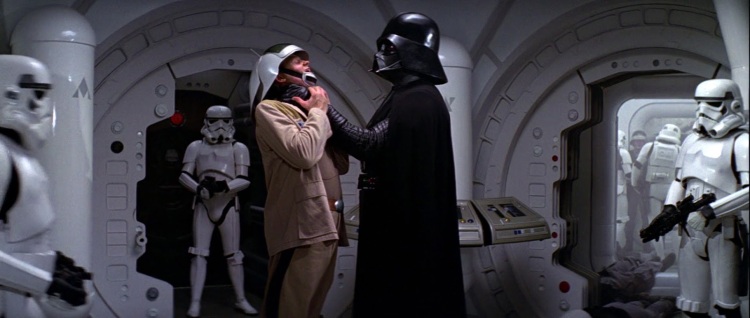
Obviously “name the scene that changed the game of cinema” is way too broad an accomplishment to narrow down, but when deciding on the three major moments that totally transformed the art form in my eyes, I settle on the Odessa steps sequence of Battleship Potemkin, the mid-film death of Marion Crane in Psycho, and the opening shot of Star Wars. And while the other two describe a scene that impacted me on an intellectual level, only the Star Wars sequence hit me on a gut eye-widening level even when I first watched it – which was, for the record, on a TV screen in the 1990s at a toy store that probably was one of the much edited Special Editions (and obviously, I’m not a caveman… at this point, I only go Despecialized or bust).
Anyway, that shot alone to remind you if you’ve seen Star Wars, because you almost certainly have (and if not, don’t both reading this review because I won’t really try to bring you up to speed and will not hold back on the spoilers), is a rebel cruiser slowly but desperately crawling above our heads in a speed that tells us enough with its blasts that it is being followed. We see in the same shot shortly after what is following it: this Goliath prism of forebodingly bleached technology with the very appropriate name of the Star Destroyer completely eating up the screen too quickly for us to prepare for its entrance, let alone have any hope that this cruiser will escape its clutches. I mean, describing it doesn’t work, you gotta see it to believe it.
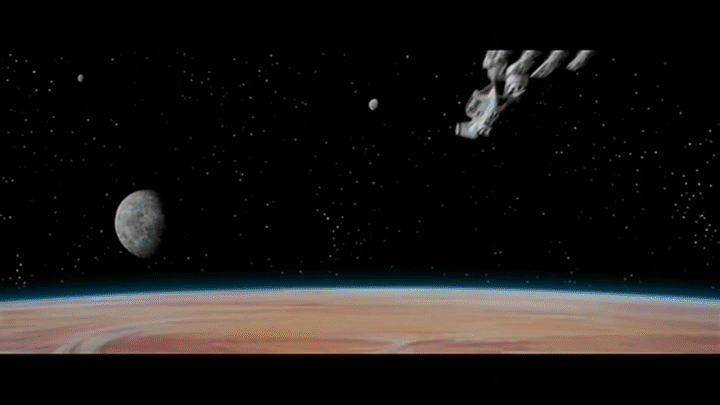
It’s like “yep… that’s a spaceship alrigh– no wait, THAAAAT’S a spaceship.” It’s more than just an incredible opening move by writer/director George Lucas to establish the dominance and antagonism of the evil Empire in less than a minute. It is in my humble opinion the most accomplished work of visual effects to date. It’s a challenge to popcorn cinema since Star Wars first opened on 25 May 1977 to try to surpass the scale and tangibility of this fantastical moment of bleeding edge technical storytelling. While visual effects have only evolved further and further down the line, nothing in my eyes has made good on the challenge (though I will say the gap in evolution between 2001: A Space Odyssey and this doesn’t feel that large). Even the dinosaurs from Jurassic Park or Gollum from The Lord of the Rings: The Two Towers feel like distant runner-ups compared to how that Star Destroyer takes me aback if I give myself enough time between viewings of Star Wars.
I mean, one doesn’t really need to recount the ways that Star Wars had affected the filmgoing sphere since it dropped like a proton torpedoes. It’s practically a joke among “sophisticated” (read: sticks-up-their-asses) cinephilia circles that the movie killed cinema along with Jaws and, sure, the sudden focus it brought in to ambitious bombastic narratively and thematically unchallenging spectacle into the 1980s is irrevocable after the thoughtful auteur-driven 1970s New Hollywood movement. But it’s very easy to fall for that spectacle when it’s this refined and bleeding edge, capable of retaining its ability to create plausible worlds to suck its audience in even 41 years after the fact. And it is apparently even easier to forget that it gets to accomplish that by having its designs tap into the malaise of New Hollywood and the disillusion of the post-Vietnam late 1970s, making it no less a bonafide member of the New Hollywood movement than Lucas’ previous two films THX 1138 and American Graffiti.

I mean, take a look at the beginnings of Tatooine farmboy-turned-hero Luke Skywalker’s (Mark Hamill) story: he lives in the middle of nowhere, just a dried desert planet so empty that just watching TWO FUCKING SUNS feels like a mundane way to vent out his boredom. And mind you, those two suns are yet another brilliant showcase of Lucas’ visual storytelling… the way Luke faces out towards the horizon telling us of the potential journeys ahead of his hopes of escape, the rising sun being the most basic of “this is the beginning of something life-changing” metaphors.
But anyway, this is diverging how Tatooine looks like it sucks, right? Because it does – the film does nothing to dress up the fatigue of the Tunisian desert it was shot in. The script by Lucas spends a little less than an hour lying inside this godforsaken sandy mass that occasionally has dunes and domes popping out from under its surface making Skywalker feel no less restless about the lack of direction in his life as any of the teenagers from American Graffiti, where Lucas seems to tap into the youthful yearning of such a hero. And mind you, the vehicles which American Graffiti revolves around (no wonder Lucas was so fascinated with having John Dykstra bring some technological logic to the models) are not glamorous but they are a sight better looking than the slim hovercraft speeder he rides around that looks more like the wheels fell off than any actual advancement was made or the rusted up massive maroon Sandcrawler from which Skywalker picks up protocol droid C-3PO (Anthony Daniels) and astromech droid R2-D2 (Kenny Baker) that take him onto his impromptu journey with the guiding old hermit Obi-Wan “Ben” Kenobi (Alec Guinness) to rescue the kidnapped Princess Leia (Carrie Fisher) from the grasp of the Empire’s main enforcers, Grand Moff Tarkin (Peter Cushing) and Darth Vader (voiced by James Earl Jones; physically played by David Prowse).
And I mean, from the moment he arrives, the gilded C-3PO is the best looking thing on Tatooine and his paint is practically fading off his body as is. When the escape pilots bad boy Han Solo (Harrison Ford) and wookie Chewbacca (Peter Mayhew) unveil their bucket of bolts the Millennium Falcon, it’s a bulky disc of a thing that makes Ben and Luke’s initial doubts understandable (though this is maybe not a feeling that translates well into the new generation, given how the Falcon is now the most beloved ship in the entire fandom). Even once they’re off that planet, the only other major locations in the film are either the clearly unstable Rebel Base looking more commandeered than fixtured within the ruins they seek quarter in and the Death Star. And my oh my does the Death Star look sterile and unwelcoming from the aged chrome that surrounds its hallways from top to bottom to the very designs of its space Nazi rebels, not least of all Vader himself sweeping through corners in a towering posture as Jones gives cold delivery to every single word he utters as he crushes throats in midair with the power of the Force.
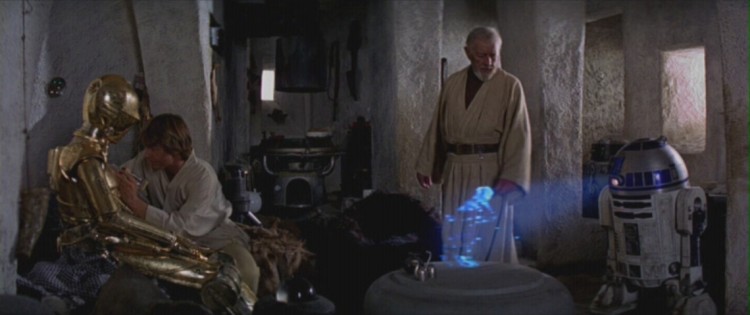
It’s a miracle the film works so well as unambiguous entertainment despite living in a world that’s not as fascinated with its own existence as we are, thanks to John Barry probably deciding to use the limited budget 20th Century Fox afforded this project to avoid glamorizing the futurism Lucas and producer Gary Kurtz envisioned and cinematographer Gilbert Taylor refusing to ease up on the grain of the film stock, practically timestamping it within 1977. And I’m sure Barry had more budget to work with than costume designer Michael Kaplan, who wisely knew how to use the texture and shade of the rags he put atop of most of the characters to signify their humble beginnings (and of course Leia doesn’t have a complex costume herself and yet the clean clarity of her white dress tells all about her hierarchy above our plucky heroes) while color-coding the alignments of our cast into good whites and evil blacks (with Vader the blackest of all, practically shining with a shadow of a cape following him). And of course, Tatooine wouldn’t be transformed without the landscape shots of second-unit photographers being the accomplished soon-to-be-household names of Tak Fujitmoto and Carole Ballard.
But my oh my, here I am establishing how accomplished visually Star Wars is as a production and I never truly got around to talking about how amazing it sounded. Because if there’s one name more attached to Star Wars than anybody except Lucas himself, it’s the incredible composer John Williams and Williams takes this opportunity to truly put the “opera” in “space opera”. Even against the “Master of Manipulative Schmaltz” Steven Spielberg, the music Williams puts into Star Wars might very well qualify as the most audience-directing work he’s done in his entire career, largely through the not-so-secret weapon of leitmotifs he adopted from the structure of operas so that we could quickly associate certain musical phrases with characters and events so that when they pop up now and again we have a sort of mapping of emotions and thoughts to guide us through story beats. Remember that duel suns thing I mentioned above and how mundane it is: we know that because of Luke’s emotions in the scene prior, the way he’s unimpressed with everything, and frankly the lack of emotiveness to Hamill’s look at the sunrise but Williams is not telling us that’s what the moment is: he’s all about driving the longing of the horizon deep into the heart of the viewer with his famous “binary sunset” theme and by god does it overpower us anyway alongside the fact that Luke may have seen a binary sunset before, but we sure as hell haven’t.
And even after Williams is the soundscape Ben Burtt designed for this universe. R2-D2 for instance famously only speaks in beeps and whistles (C-3PO is the anglicized one of the pairing) and Burtt’s intuitive enough about the range of sounds to give R2 a true identity and personality enough to recognize him as a little trouble-maker full of energy is a miracle of character creation simply from knowing what sounds can communicate that. Or the lasers, not least of which the trance-like neutrality of the fucking laser sword lightsabers or the excitement of the crackling and spitting those things make when they’re in contact, something to make the otherwise frankly boring battle between Vader and Ben feel more violent and charged. Burtt and Williams collectively are the best things Star Wars have going for it and the unsung creators of an audial world that allowed already transporting visuals to occupy our hearts in a primal invisible way, answering why 1/4 of its 6 Oscars went for its sound and music (the others being Best Art Direction, Best Costume Design, Best Visual Effects, and Best Film Editing).
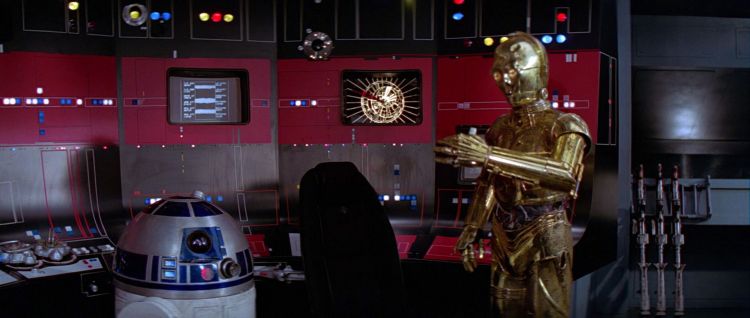
Which leaves the misfortune of having to recognize that these accomplishments in craft are given the task of carrying less than stellar writing and acting. The writing itself is easier to pinpoint. It is the opinion of yours truly that the scripts of every Star Wars film are always the weakest link and the 1977 original certainly gave a decent enough jump start to that tradition, but its adherence to the cliché Hero’s Journey of Campbell that Lucas espoused so highly is hardly criminal in itself and it’s certainly a broad line for which Williams to follow and amplify through his music. It’s the dialogue: excusable maybe to those who have no problems with in-universe kludges of proper nouns, but it’s all chewy and clunky when the cast has to use those nouns and unsubtle direct plot-plodding when they don’t. The fact that the majority of the cast feel unconvinced with the diatribes on the Force and the Empire that they have to deliver makes it all so much less believable and truly makes Williams’ work cut out for him.
Which may as well segue to the cast, but at least they do have their high points: for one thing, Cushing’s gaunt grey-haired skull-like visage already does well enough to communicate his somber wickedness and then he has to add a sort of smacking sneer to his threats and interrogations that blow my mind how he can accomplish that without even the shadow of a smile cracking. Then there’s all the non-verbal characters: Mayhew and Baker able to use body language in their limited roles to feel friendly and in some cases scene-stealing. And while I understand Guinness’ famous hatred of Star Wars, he’s frankly one of the best actors in the world and can turn even a expositioning old man like Ben into a viable source of guidance to what our heroes objectives are and the possibilities they can achieve with the help of the force. And frankly, between Guinness here and Hamill in the later film The Last Jedi, it’s quite possible that cynical jaded actors who have doubt about the direction of their characters make for the best aged and tired performances of long-lost heroes trying to prepare their successors for what is to come.
Sadly, Hamill does not accomplish anything as brilliant as The Last Jedi here: he is frankly wan and whiny in a petulant off-putting way, like a grown child that doesn’t make for a compelling surrogate to the audience. And meanwhile, none of his major co-stars Ford or Fisher do as well either: Fisher’s pronunciation of words between her teeth is so naggingly conscious that it feels like a college freshman trying to do an overexaggerated British accent on stage and Ford’s cockiness is quite honestly the best out of the three but doesn’t sell one bit on the moral ambiguity we’re supposed to buy from the character before his big saving return in the climax through the trenches. I’d probably prefer to say more about their performances when I get to the sequels where they improve significantly, because wallowing in a trio of amateur actors at the beginning of their careers feels quite mean.
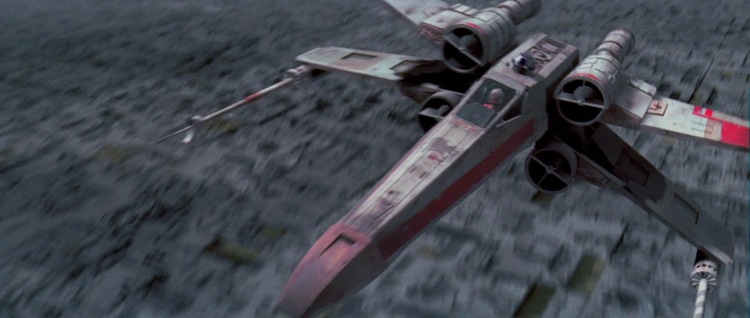
Let’s instead return to what makes me high off of Star Wars and choose the afore-mentioned trench run climax as a brilliant metaphor to how the experience of Star Wars shakes me as a viewer. Luke’s rushing through all these details surrounding him deep on the surface of the Death Star and there’s so much thought put into their construction and grounding them all within the same universe and yet he barely recognizes them nor do we. We’re just on the ecstasy of the speed in which we’re exploring this surface towards our destination. Meanwhile, three crooked looking eyeball-esque TIE fighters are on his tail with Vader closing in and it brings a sense of danger and urgency to scene beyond everything else. And then there’s the moment where we hear Guinness’ warm voice calm Luke and us down and re-assure us that this is a story where we know the ending and that the good guys will prevail, the certainty that gives Luke confidence to abandon the missile-guiding system, the cheeriness that accompanies Solo’s entrance as he gets the TIE fighters off of Luke, and most of all the exhilaration we have at witnessing Luke make a bullseye at the ventilation shaft, punctuated by the explosive blast of the Death Star’s destruction just as Luke zooms away.
So many different emotions communicated to us at lightning speed thanks to the factors all collected and arranged by the editors Marcia Lucas (George’s former wife), Paul Hirsch, and Richard Chew. And all with the trust and direction of Lucas, a man who probably later on invited ridicule for his overwhelming inability to tell a complex or nuanced story, but for now carried an ambitious desire to create some semblance of new worlds, even out of a limited number of locations and none of them as fantastical as one would think, and transport us there. And frankly, Star Wars isn’t a story that needs nuance or complexity. The attempt to input it feels like the failing of most Star Wars movies I’m not fond of. Sometimes, you can provide intelligent popcorn cinema simply by trusting the sounds and designs to magnify the emotions the story can barely give us and Star Wars does that in such a kinetic way that I can’t imagine how anybody could leave it feeling unstimulated.
It lifts me up and takes me back a long long time ago in a galaxy far far away.
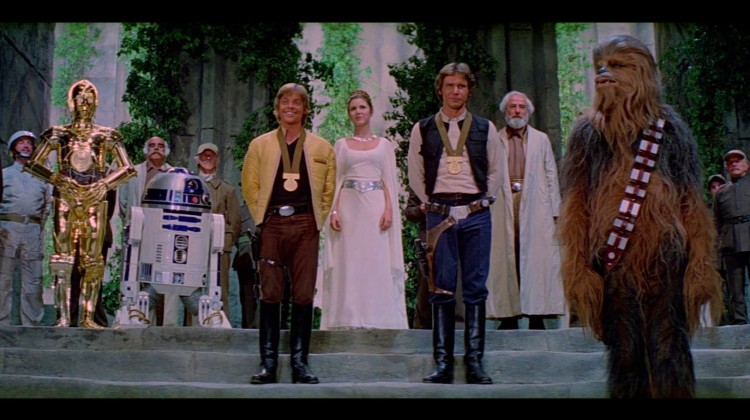
Actually, Chewbacca deserves a medal. Fuck this movie, it’s the worst.
